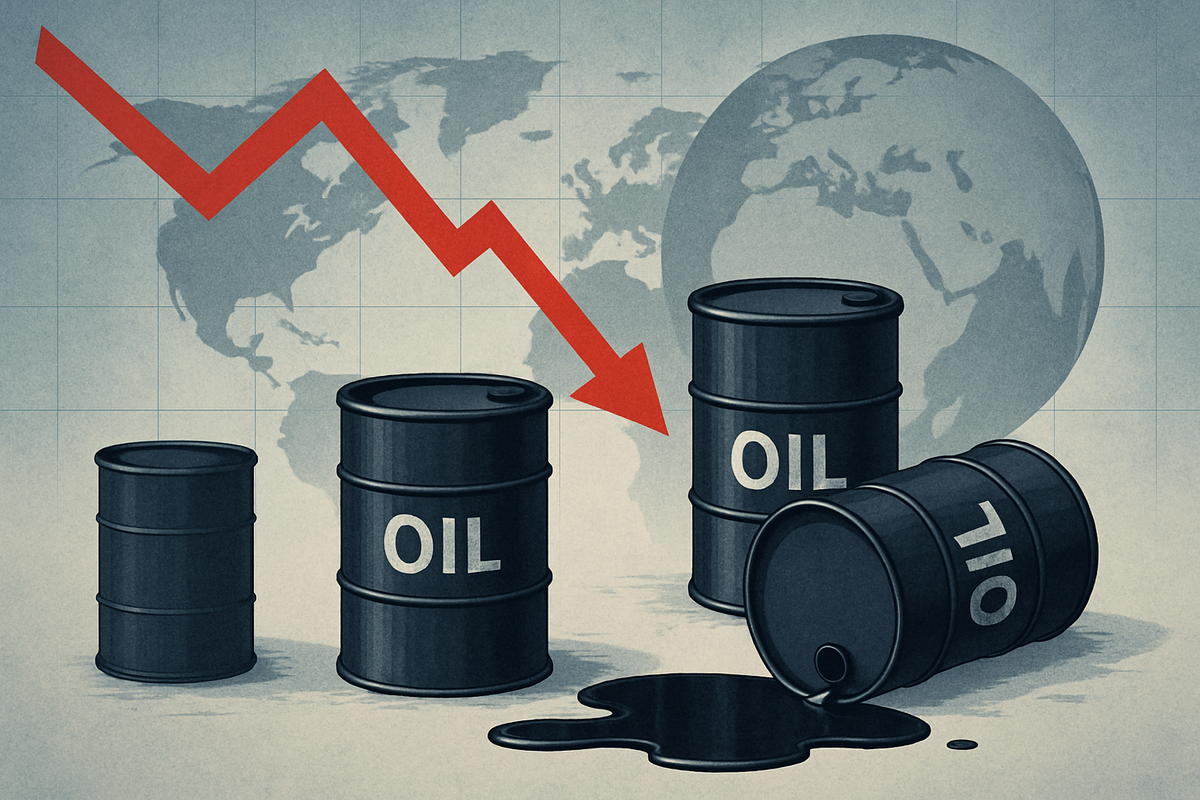
The global oil market has been gripped by a significant downturn, with both major crude benchmarks, Brent and West Texas Intermediate (WTI), experiencing a slide of over ten percent in recent weeks. As of October 17, 2025, Brent crude futures are hovering just below $62 a barrel, marking a substantial decline of 7.83% over the past month and a staggering 16.29% year-over-year. Similarly, WTI crude futures have fallen to approximately $58.3 per barrel, a 7.63% drop in the preceding month, hitting multi-month lows not seen since May. This sharp decline signals a profound shift in market dynamics, raising concerns about global economic stability and the profitability of energy-dependent sectors.
This sustained price erosion is primarily attributed to a confluence of factors: a looming global oil surplus, moderating demand growth, escalating US-China trade tensions, and a significant de-escalation of geopolitical tensions that had previously supported prices. The immediate implications are a mixed bag; while consumers may find relief at the fuel pumps, easing inflationary pressures, the underlying causes of the slide—particularly trade disputes and a challenging macroeconomic climate—cast a shadow over broader economic growth prospects. For oil-exporting nations and energy companies, the downturn presents considerable financial headwinds, forcing a reevaluation of budgets and investment strategies.
Unpacking the Decline: A Detailed Look at Recent Events
The period leading up to and including October 17, 2025, has been marked by a relentless downward trajectory in oil prices.
Specific Details and Timeline of Events:
- September 2025: OPEC+ announced a modest increase in oil production by 137,000 barrels per day (bpd) for October, signaling a strategic shift towards regaining market share rather than solely defending higher prices. This move followed earlier production increases throughout the year.
- Early October 2025: Brent crude began its notable descent, falling by $4/bbl to $64/bbl. Speculation about further OPEC+ production quota increases, despite tepid global consumption, fueled bearish sentiment.
- October 3, 2025: A critical ceasefire agreement between Israel and Hamas reportedly eased geopolitical war risk premiums that had previously lent support to oil prices.
- October 10, 2025: International crude oil prices plunged over 3% after US President Donald Trump announced a full ban on rare earth mineral exports from China and imposed new controls on critical software exports, further escalating US-China trade tensions. China retaliated with export controls on rare earth metals, effective December 1.
- Week of October 13-17, 2025:
- IEA Reports: The International Energy Agency (IEA) released its October 2025 Oil Market Report, significantly increasing its forecast for a global oil surplus to a record 4 million bpd in 2026 and revising down demand growth estimates for 2025 and 2026 to approximately 700,000 bpd. This reinforced expectations of a substantial surplus.
- US Crude Inventories: The U.S. Energy Information Administration (EIA) reported consecutive weekly builds in commercial crude oil inventories, with increases of 3.5 million barrels and 3.7 million barrels in the weeks leading up to October 10. This signaled weaker demand in the US, the world's largest oil-consuming nation, while US crude oil production hit a record 13.636 million bpd.
- Geopolitical Developments: President Trump announced plans to meet Russian President Vladimir Putin to discuss an end to the war in Ukraine, raising the likelihood of increased Russian oil exports and further eroding geopolitical risk premiums.
- Economic Slowdown Fears: Reports of bad loans from two US regional banks, Zions Bancorp and Western Alliance, on October 16, triggered concerns of an early sign of a US economic slowdown, wiping out $100 billion in market cap from the banking sector. The IMF also noted that global economic growth is expected to slow.
Key Players and Stakeholders Involved:
- OPEC+: The group of oil-producing nations, including Saudi Arabia and Russia, whose production decisions directly impact global supply. Their strategy to gradually unwind cuts has contributed to the current surplus.
- United States: The Trump administration's trade policies with China and diplomatic overtures towards Russia significantly influence market sentiment and supply/demand dynamics.
- China: As a crucial driver of global oil consumption, China's economic health and trade relations are paramount.
- International Energy Agency (IEA) and US Energy Information Administration (EIA): These agencies provide critical data and forecasts that shape market expectations regarding supply and demand.
- Oil Traders and Analysts: Their reactions to market signals drive short-term price movements and future outlooks.
Initial Market or Industry Reactions: The prevailing sentiment has been overwhelmingly bearish, leading to significant price declines and heightened volatility. The market has shifted into a contango structure, where future prices are higher than spot prices, indicating an oversupplied market and encouraging storage. Oil producers, particularly those with higher break-even costs, are facing immense pressure on profitability, with some US shale companies reportedly needing prices above $65 per barrel to drill profitably. Conversely, the decline offers immediate relief to consumers at the fuel pumps.
Winners and Losers: Corporate Impact of Falling Oil Prices
A sustained over ten percent slide in oil prices creates a clear divide between industries and public companies, generating beneficiaries and those facing significant headwinds.
Companies That Might Win
1. Airlines: Companies like Southwest Airlines Co. (NYSE: LUV), Delta Air Lines Inc (NYSE: DAL), United Airlines (NASDAQ: UAL), and American Airlines (NASDAQ: AAL) are direct winners. Jet fuel represents a substantial portion of their operating costs. Lower fuel prices directly translate into improved profit margins, and potentially more competitive fares, stimulating demand. European carriers such as Ryanair (NASDAQ: RYAAY) also stand to benefit.
2. Transportation and Logistics Companies: FedEx Corp (NYSE: FDX) and United Parcel Service (NYSE: UPS), along with other trucking and shipping firms, benefit from reduced fuel expenses. While many contracts include fuel surcharges, a sustained decline can still lead to higher overall margins and potentially increased freight volumes as businesses benefit from lower shipping costs.
3. Chemical Companies: Manufacturers using crude oil derivatives as feedstocks, such as PPG Industries (NYSE: PPG) and Sherwin-Williams (NYSE: SHW) (which acquired Valspar), will see significant reductions in raw material costs. This includes producers of plastics, paints, and specialty chemicals, leading to expanded profit margins.
4. Consumer Discretionary and Staples: Lower gasoline prices leave consumers with more disposable income, potentially boosting spending on non-essential goods and services. Retailers like Target (NYSE: TGT) and Dollar General (NYSE: DG), restaurant chains like Darden Restaurants Inc (NYSE: DRI), and leisure companies such as Royal Caribbean Cruises Ltd (NYSE: RCL) and Walt Disney Company (NYSE: DIS) could see increased demand. Automakers also benefit as lower fuel costs can incentivize purchases of larger, higher-margin vehicles.
5. Downstream Oil Refiners: Pure-play refining companies like Valero Energy (NYSE: VLO) and Marathon Petroleum (NYSE: MPC) often profit from the "crack spread" – the difference between crude oil and refined product prices. When crude prices fall faster than refined product prices, refining margins can expand, allowing them to purchase cheaper inputs and sell at relatively stable prices.
Companies That Might Lose
1. Upstream Oil and Gas Producers: Exploration and production (E&P) companies, especially smaller, independent firms focused on higher-cost production (e.g., shale oil), are the primary losers. Their revenues are directly tied to oil prices. Integrated oil majors like ExxonMobil (NYSE: XOM), Chevron (NYSE: CVX), BP (NYSE: BP), and Shell (NYSE: SHEL) will also see their upstream earnings severely impacted, leading to potential cuts in capital expenditure and re-evaluation of projects. Many US shale producers require prices above $60-$65 per barrel to drill profitably, making the current environment challenging.
2. Oilfield Services Companies: Major players such as SLB (NYSE: SLB) (formerly Schlumberger), Halliburton (NYSE: HAL), and Baker Hughes (NASDAQ: BKR) provide essential services to E&P firms. When oil prices fall, producers cut drilling activity and capital budgets, directly reducing demand for oilfield services, leading to lower revenues and increased pricing pressure.
3. Industrial Companies (Suppliers to the Oil & Gas Sector): Manufacturers of steel, machinery, and heavy equipment that supply the energy industry, like Caterpillar (NYSE: CAT), will experience reduced demand for their products as E&P companies scale back operations.
4. Financial Companies with Energy Sector Exposure: Regional banks in oil-producing regions or investment firms holding debt from energy companies, such as Cullen/Frost Bankers (NYSE: CFR), face increased credit risks, potential debt defaults, and higher loan losses from struggling oil and gas firms.
Wider Significance: Trends, Ripple Effects, and Historical Parallels
The sustained slide in oil prices leading up to October 17, 2025, is more than a momentary market fluctuation; it represents a significant shift with broader implications for global industry trends, economic stability, and policy decisions.
Broader Industry Trends: This downturn is a continuation of a bearish trend throughout 2025, primarily driven by a persistent global oil surplus. Robust non-OPEC+ production, particularly from the US, Brazil, and Canada, is projected to accelerate this oversupply into 2026. US crude oil production has reached a record 13.5 million bpd, further exacerbating the glut. Concurrently, global demand growth is moderating due to a challenging macroeconomic climate, ongoing US-China trade tensions, and the accelerating energy transition, including the adoption of electric vehicles. The market's shift into a contango structure (where future prices are higher than spot prices) is a strong bearish signal, encouraging storage and indicating expectations of a prolonged surplus.
Potential Ripple Effects on Competitors and Partners:
- Oil Producers: E&P companies face squeezed revenues and profits, potentially leading to curtailed investment plans and project delays. Smaller, highly leveraged producers are particularly vulnerable to financial distress.
- Oil-Exporting Nations: Countries heavily reliant on oil exports, such as Saudi Arabia, Russia, and many African nations (whose budgets are benchmarked above $75/bbl), will face significant fiscal challenges, revenue shortfalls, and currency pressures.
- Oil-Importing Nations: These nations generally benefit from lower import costs, easing inflationary pressures and potentially boosting consumer spending.
- Renewable Energy Sector: While long-term decarbonization goals are unlikely to be derailed, persistently low oil prices could temporarily reduce the perceived urgency or cost-competitiveness of some renewable energy projects, potentially slowing the pace of transition in the short term. However, 72% of investors are accelerating their 2025 investments in energy transition assets, indicating a robust long-term commitment.
Regulatory or Policy Implications:
- OPEC+ Strategy: The alliance faces immense pressure to manage market share versus price stability. While they have increased production, sustained low prices may force them to reconsider deeper production cuts to prevent a further price crash, potentially leading to internal disagreements.
- Government Responses: Oil-exporting nations may need to implement austerity measures or seek alternative revenue streams to offset reduced oil income.
- Trade Policies: The ongoing US-China trade war continues to inject volatility and uncertainty into the market, impacting global economic growth and oil demand.
- Energy Transition Policies: Policymakers must balance encouraging the energy transition with ensuring energy security, especially during periods of low conventional fuel prices.
Historical Precedents and Comparisons: The current oil price downturn shares notable similarities with past events:
- 2014-2015 Price Crash: This was largely driven by the rapid growth of US tight oil production, a factor still contributing to the current oversupply.
- 1980s Oil Glut: This period saw increased non-OPEC production and reduced demand, mirroring the current supply-driven oversupply compounded by moderating demand.
- 2020 Pandemic Collapse: While not as extreme, the current decline is similarly characterized by a slowdown in demand, albeit less severe than the unprecedented collapse during COVID-19.
- 2008 Financial Crisis: This crisis saw a demand collapse and financial panic, causing oil prices to plummet, a scenario that also involved moderating demand, although the macroeconomic triggers were different.
What Comes Next: Navigating an Uncertain Future
The sustained over ten percent slide in oil prices presents a complex outlook for the global energy market, with both short-term challenges and long-term structural shifts.
Short-Term Possibilities (Q4 2025 - 2026):
- Continued Price Decline: The EIA forecasts Brent crude to average around $62 per barrel in Q4 2025, potentially dropping to $52 per barrel in 2026, with WTI following suit.
- Inventory Builds: Global oil inventories are projected to build substantially due to persistent oversupply, averaging 2.6 million barrels per day in Q4 2025.
- OPEC+ Response: OPEC+ may face increasing pressure to adjust its strategy and potentially implement deeper production cuts to prevent further price erosion, though internal disagreements could arise.
- U.S. Shale Slowdown: If WTI prices remain below the $60 per barrel threshold, US oil production growth could slow or even decline by 200,000-300,000 bpd in 2026, impacting future supply.
- Consumer Benefits: Lower crude prices are expected to translate into cheaper gasoline and diesel, alleviating inflationary pressures and potentially boosting discretionary spending.
Long-Term Possibilities (Beyond 2026):
- Lower Price Range: Oil prices are generally expected to remain in a lower range or continue a gradual decline beyond 2026.
- Peak Demand by 2030: Global fossil fuel demand is widely anticipated to peak by 2030, driven by accelerating energy transition policies and widespread electric vehicle adoption.
- Underinvestment Risks: Prolonged low prices could lead to significant underinvestment in new production capacity, potentially creating supply constraints in the future as existing fields decline.
Strategic Pivots or Adaptations Required:
- For Oil Producers: Companies must prioritize capital discipline, cost reduction, and efficiency improvements. Diversification into natural gas and other energy sources will be crucial. High-cost producers, particularly in African nations, will face severe fiscal challenges, necessitating budget adjustments and currency management.
- For Oil-Importing Nations: These nations can leverage lower oil prices to stimulate economic growth and accelerate investments in renewable energy infrastructure.
- For Renewable Energy Sector: While lower oil prices might temporarily reduce the immediate economic incentive for some, long-term policy drivers and technological advancements are expected to continue supporting the energy transition.
- For Financial Institutions: Robust risk management and careful assessment of investment portfolios will be essential due to increased market volatility and potential credit risks from oil-dependent entities.
Market Opportunities or Challenges That May Emerge:
- Opportunities: Cost savings for consumers and businesses, economic stimulus, strategic stockpiling by nations like China, and potential M&A activity in a depressed market.
- Challenges: Revenue shortfalls for producers, investment cuts in new capacity, potential geopolitical instability despite recent easing, and the challenges of a "contango" market structure.
Potential Scenarios and Outcomes:
- "Lower for Longer" Scenario: The most widely forecast scenario, with oil prices remaining subdued ($50-$65/bbl) through 2026 and beyond, driven by sustained oversupply and muted demand.
- OPEC+ Cohesion and Market Rebalancing: OPEC+ takes more decisive action to cut production, and non-OPEC+ supply growth slows, leading to a modest price recovery.
- Geopolitical Disruption and Price Spike: New or escalating conflicts in key oil-producing regions could lead to rapid, temporary price surges, despite the current easing of tensions.
- Accelerated Energy Transition: Robust global commitment to decarbonization, coupled with technological advancements, leads to a faster-than-expected peak in oil demand, structurally suppressing long-term prices.
Comprehensive Wrap-Up: Navigating the New Energy Landscape
The sustained slide of over ten percent in oil prices leading up to October 17, 2025, marks a critical juncture in the global energy market. This downturn, driven by a persistent oversupply from non-OPEC+ nations, moderating global demand, escalating US-China trade tensions, and eased geopolitical risk premiums, has reshaped market expectations and necessitates strategic adaptations across industries.
Summary of Key Takeaways: The core issue is a significant global oil surplus, exacerbated by robust US shale production and a gradual unwinding of OPEC+ cuts, coinciding with a slowdown in demand growth due to macroeconomic headwinds and the accelerating energy transition. The strengthening US dollar and a reduction in geopolitical risk premiums have further amplified the downward pressure on prices.
Assessment of the Market Moving Forward: The consensus among analysts points to a "lower for longer" scenario, with prices likely to remain subdued through 2026. Global inventories are expected to continue building, maintaining pressure on prices. While OPEC+ may eventually intervene with deeper cuts if prices fall too far, their current strategy suggests a focus on market share. The future trajectory of US shale production will also be crucial, as sustained low prices could force a slowdown.
Final Thoughts on Significance and Lasting Impact: This price slide offers a temporary reprieve for consumers and oil-importing nations, easing inflationary pressures and potentially boosting discretionary spending. However, for oil-producing nations and energy companies, it presents significant financial challenges, necessitating economic diversification and capital discipline. The impact on the energy transition is complex; while lower fossil fuel prices might temporarily reduce the immediate incentive for some, the long-term commitment to decarbonization and technological advancements are expected to drive the shift towards renewables. The lasting impact will likely be a reordering of global energy priorities, with a greater emphasis on cost efficiency and resilience in a volatile market.
What Investors Should Watch For in Coming Months: Investors should closely monitor OPEC+ decisions on production targets, global oil inventory levels, and any developments in US-China trade relations. Macroeconomic indicators, including global GDP growth and central bank monetary policies, will continue to influence overall energy demand. Furthermore, tracking US shale production trends and geopolitical events in key oil-producing regions will be essential. Finally, for long-term investors, observing the momentum of the energy transition, including EV adoption rates and renewable energy investments, will provide insights into the structural shifts shaping the future of energy. Companies that demonstrate capital discipline, operational efficiency, and a clear strategy for navigating the energy transition will be better positioned for success.
This content is intended for informational purposes only and is not financial advice






